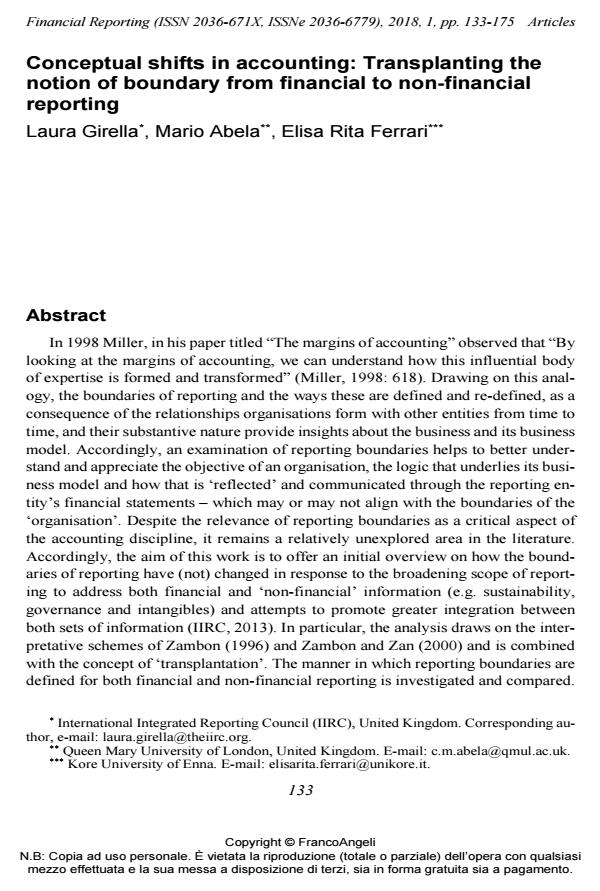Conceptual shifts in accounting: Transplanting the notion of boundary from financial to non-financial reporting
Journal title FINANCIAL REPORTING
Author/s Laura Girella, Mario Abela, Elisa Rita Ferrari
Publishing Year 2018 Issue 2018/1
Language English Pages 43 P. 133-175 File size 464 KB
DOI 10.3280/FR2018-001005
DOI is like a bar code for intellectual property: to have more infomation
click here
Below, you can see the article first page
If you want to buy this article in PDF format, you can do it, following the instructions to buy download credits

FrancoAngeli is member of Publishers International Linking Association, Inc (PILA), a not-for-profit association which run the CrossRef service enabling links to and from online scholarly content.
In 1998 Miller, in his paper titled "The margins of accounting" observed that "By looking at the margins of accounting, we can understand how this influential body of expertise is formed and transformed" (Miller, 1998: 618). Drawing on this analogy, the boundaries of reporting and the ways these are defined and re-defined, as a consequence of the relationships organisations form with other entities from time to time, and their substantive nature provide insights about the business and its business model. Accordingly, an examination of reporting boundaries helps to better understand and appreciate the objective of an organisation, the logic that underlies its business model and how that is ‘reflected’ and communicated through the reporting entity’s financial statements - which may or may not align with the boundaries of the ‘organisation’. Despite the relevance of reporting boundaries as a critical aspect of the accounting discipline, it remains a relatively unexplored area in the literature. Accordingly, the aim of this work is to offer an initial overview on how the boundaries of reporting have (not) changed in response to the broadening scope of reporting to address both financial and ‘non-financial’ information (e.g. sustainability, governance and intangibles) and attempts to promote greater integration between both sets of information (IIRC, 2013). In particular, the analysis draws on the interpretative schemes of Zambon (1996) and Zambon and Zan (2000) and is combined with the concept of ‘transplantation’. The manner in which reporting boundaries are defined for both financial and non-financial reporting is investigated and compared. This comparison enables similarities and differences between the definition of the ‘reporting boundary’ to be problematised and explored for both financial and non-financial reporting.
Keywords: Reporting boundaries, financial reporting, non-financial reporting, transplantation.
- Corporate governance: Search for the advanced practices Francesco De Luca, Ho-Tan-Phat Phan, pp.177 (DOI:10.22495/cpr19p9)
- Paradise Lost: Accounting Narratives Without Numbers Mario Abela, in Accounting, Economics, and Law: A Convivium 20190035/2020
DOI: 10.1515/ael-2019-0035 - The level of compliance with the Italian Legislative Decree No. 254/2016 and its determinants: Insights from Italy Valter Cantino, Alain Devalle, Simona Fiandrino, Donatella Busso, in FINANCIAL REPORTING 1/2019 pp.113
DOI: 10.3280/FR2019-001004 - Mandatory and Discretional Non-financial Disclosure after the European Directive 2014/95/EU pp.117 (ISBN:978-1-83982-505-7)
- Informativeness Assessment of Risk and Risk-Management Disclosure in Corporate Reporting: An Empirical Analysis of Italian Large Listed Firms Francesco De Luca, Ho-Tan-Phat Phan, in FINANCIAL REPORTING 2/2019 pp.9
DOI: 10.3280/FR2019-002002 - The assurance of non-financial disclosure: A longitudinal analysis of the academic and professional literature Michele Guidi, Marco Giuliani, Maria Serena Chiucchi, Stefano Marasca, in FINANCIAL REPORTING 2/2021 pp.5
DOI: 10.3280/FR2021-002001
Laura Girella, Mario Abela, Elisa Rita Ferrari, Conceptual shifts in accounting: Transplanting the notion of boundary from financial to non-financial reporting in "FINANCIAL REPORTING" 1/2018, pp 133-175, DOI: 10.3280/FR2018-001005